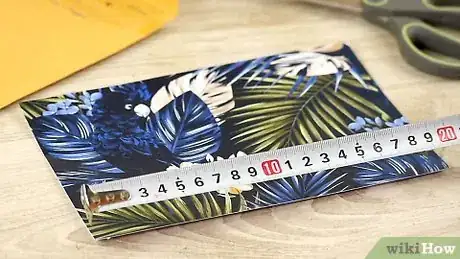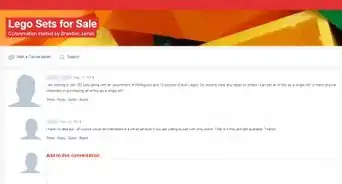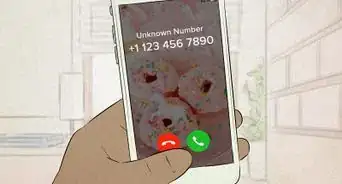This article was co-authored by wikiHow staff writer, Megaera Lorenz, PhD. Megaera Lorenz is an Egyptologist and Writer with over 20 years of experience in public education. In 2017, she graduated with her PhD in Egyptology from The University of Chicago, where she served for several years as a content advisor and program facilitator for the Oriental Institute Museum’s Public Education office. She has also developed and taught Egyptology courses at The University of Chicago and Loyola University Chicago.
There are 18 references cited in this article, which can be found at the bottom of the page.
The wikiHow Video Team also followed the article's instructions and verified that they work.
This article has been viewed 28,805 times.
Learn more...
If you need to ship an art print, you may be worried about how to package it so that it will arrive safe and undamaged. Luckily, you can package your prints securely and economically with just a few basic supplies! For smaller prints, a flat mailer is ideal. If your pint is extra-large or poster-sized, however, it’s best to roll it up and package it in a tube.
Steps
Using Flat Packaging
-
1Measure your print to determine the right packaging size. To package your prints properly, you’ll need to buy appropriately sized packing material. If you don’t already know the size of the print, measure it before you obtain any sleeves or envelopes.
- For example, if your print is 8.5 by 11 inches (22 by 28 cm), a 9.75 by 12.25 in (24.8 by 31.1 cm) rigid mailing envelope will work well.
-
2Slide a cardboard backing sheet into a sealable plastic sleeve. Get a sheet of stiff cardboard or chipboard that is the same size as your print or slightly larger. Slip it into a clear plastic art sleeve with an adhesive top.[1]
- You can purchase plastic art sleeves online, from shipping supply stores, or from arts and crafts stores. Look for bags that are labeled “Acid Free” and “Archival Safe.”
- Purchase chipboard sheets from a packing supply or craft store, or cut your own backing sheets from old cardboard boxes with a precision knife.
- The backing sheet will help ensure that your print doesn’t get bent.
Advertisement -
3Insert the print into the plastic sleeve face up. Carefully slide your print into the plastic sleeve on top of the cardboard or chipboard backing sheet. Make sure the design on the print is facing out so that it will be visible when the recipient takes it out of the package.[2]
- To ensure the best visibility, put your print in the bag so the adhesive seal is on the opposite side from the front of the print when you close the bag.
-
4Seal the sleeve with the print and cardboard inside. Peel the protective strip off of the adhesive on the plastic sleeve. Carefully fold the top of the sleeve over and press it down to seal it.[3]
-
5Place the print inside a rigid mailing envelope. Slip the plastic sleeve containing the print into a mailer that’s stiff enough not to bend easily. Seal the top of the envelope with the adhesive strip.[6]
- For extra security, put a little packaging tape across the back flap of the envelope.
-
6Label the envelope “Do Not Bend”. To help ensure that mail handlers take extra care with your packaged print, put a “Do Not Bend” sticker or stamp on the outside of the envelope.[7]
- You can also purchase envelopes that already have “Do Not Bend” printed on them.
Putting Prints in a Mailing Tube
-
1Use tubes for large prints and posters. While flat envelopes work well for smaller prints, tubes are ideal for extra large or poster-sized prints. Look for a mailing tube that’s slightly longer than the shortest edge of your print.[8]
- For example, if you have a 16 by 20 in (41 by 51 cm) print, shipping in a tube will be safer and cheaper than shipping it flat.
- You can purchase sturdy cardboard shipping tubes from most shipping supply stores. If you’re really concerned about your print getting damaged in the mail, you can also ship it in a length of PVC pipe.[9]
-
2Place the print on a piece of kraft paper slightly larger than the print. Cut out a large piece of craft paper that’s slightly longer and wider than your print. Carefully lay the print out on top of it.[10]
- Rolling the print up in craft paper will provide an extra layer of protection against dirt, smudges, and scratches.
- Alternatively, you can use an archival paper such as Tyvek or Glassine.[11] These papers are specially designed to protect delicate art and prints, but they are more expensive than basic kraft paper.
-
3Fold the ends of the paper over the top and bottom of the print. Before you start rolling the print, fold the kraft paper up and over the 2 shorter edges of the print. This will provide some extra protection along the edges, which can easily get bent or torn during the packaging and shipping process.[12]
- If you’re shipping multiple prints in one tube, protect them from damaging each other by layering sheets of craft or archival paper between each print.[13]
-
4Roll the print up carefully inside the kraft paper. Very carefully begin to roll your print, starting from one of the short edges. Begin the roll with a gentle curve so that you don’t accidentally bend or wrinkle your print. Roll it up tightly enough so that it can slide easily into the tube, but not so tightly that you risk damaging the print.[14]
- If you notice any sharp folds or bends starting to form, unroll the print and start again, this time rolling more loosely.[15]
-
5Secure the rolled-up print with stickers, tape, or twine. Once you’re satisfied with the way you’ve rolled your print, you’ll need to secure it so it won’t start to unroll before you can get it into the tube. Place 1 or 2 stickers along the edge of the roll, use some pieces of plain or decorative tape, or tie a bit of twine around the middle of the tube.[16]
- You can also slip the print into a rolled poster bag if you prefer. You can purchase these bags from shipping supply stores.
Tip: If you like, you can attach a thank you note or your business card to the twine or slip it in under the edge of the roll at this point.[17]
-
6Tuck in the edges of the kraft paper at the ends of the roll. When the print is rolled up, there should still be a small amount of kraft or archival paper sticking out at each end. Carefully tuck in the ends to help protect the edges of your print from crumpling or getting ripped.[18]
- Be careful not to fold or bend the edges of your print when you’re tucking in the paper.
-
7Slide the print into a mailing tube with a cap on one end. Insert a fitted plastic cap onto one end of the mailing tube, then carefully slip your print inside. Take care not to damage the end of your print when you’re sliding it in.[19]
- Don’t try to force the print into the tube if it doesn’t slip in easily. You’ll risk damaging the print, and it will also be harder to safely remove it from the tube if the fit is too tight.[20]
-
8Put some wadded-up paper or other filler in the end of the tube. Your print can become damaged if it shifts around inside the tube during shipping. To prevent this, wad up a little kraft paper, tissue paper, or bubble wrap and insert it into the end of the tube to fill up any empty space.[21]
- Pack the end of the tube loosely so you don’t crush the top edge of your print when you close the tube.
-
9Cap the other end of the tube and tape the caps on. Insert the cap into the top end of the tube, then use packaging tape to secure both ends. For extra security, place several strips of tape over each end in a “star” or “asterisk” shape, then wrap a circle of tape around the end of the tube to secure the first layer of tape in place.[22]
- Most mailing tubes come with fitted end caps, or you can purchase caps that match your mailing tubes separately from a shipping supply store. You can also cut caps to size out of thick cardboard or chipboard.
- Don’t simply put tape across the open ends of the tube. Your print could stick to the tape and get damaged.
Things You’ll Need
Using Flat Packaging
- Cardboard or chipboard backing sheet
- Acid-free self-adhesive plastic sleeve
- Rigid mailing envelope
- “Do Not Bend” sticker or stamp
Putting Prints in a Mailing Tube
- Kraft paper or archival paper
- Stickers, tape, or twine
- Sturdy mailing tube
- End caps for your mailing tube
- Packaging tape
References
- ↑ https://youtu.be/uqq8uWHpOhg?t=182
- ↑ https://youtu.be/uqq8uWHpOhg?t=240
- ↑ https://youtu.be/uqq8uWHpOhg?t=259
- ↑ https://youtu.be/0epUV8iuktU?t=218
- ↑ https://youtu.be/IfrvLGVysAY?t=243
- ↑ https://youtu.be/uqq8uWHpOhg?t=291
- ↑ https://youtu.be/0epUV8iuktU?t=201
- ↑ https://youtu.be/0epUV8iuktU?t=425
- ↑ https://youtu.be/c-KMi3S_zfE?t=186
- ↑ https://youtu.be/0epUV8iuktU?t=470
- ↑ https://www.agora-gallery.com/advice/blog/2016/10/06/how-to-roll-artworks-for-shipping/
- ↑ https://youtu.be/0epUV8iuktU?t=482
- ↑ https://www.agora-gallery.com/advice/blog/2016/10/06/how-to-roll-artworks-for-shipping/
- ↑ https://youtu.be/0epUV8iuktU?t=520
- ↑ https://www.agora-gallery.com/advice/blog/2016/10/06/how-to-roll-artworks-for-shipping/
- ↑ https://youtu.be/0epUV8iuktU?t=571
- ↑ https://youtu.be/0epUV8iuktU?t=634
- ↑ https://youtu.be/0epUV8iuktU?t=616
- ↑ https://youtu.be/0epUV8iuktU?t=645
- ↑ https://www.agora-gallery.com/advice/blog/2016/10/06/how-to-roll-artworks-for-shipping/
- ↑ https://youtu.be/0epUV8iuktU?t=648
- ↑ https://www.agora-gallery.com/advice/blog/2016/10/06/how-to-roll-artworks-for-shipping/
































































